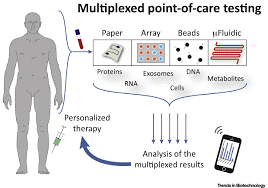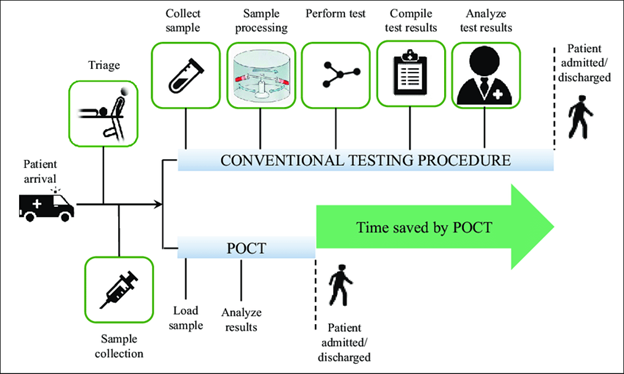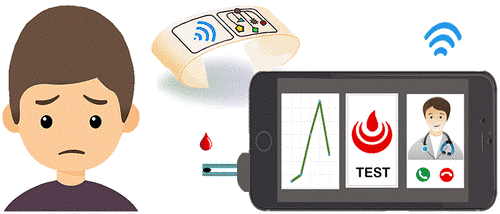In today’s rapidly evolving healthcare landscape, Point-of-Care Testing (POCT) devices play a crucial role in delivering timely and accurate diagnostic information. These devices provide healthcare professionals with the ability to perform tests and obtain results at or near the patient’s location, significantly improving patient care and treatment outcomes. Furthermore, advancements in biosensors, nanotechnology, smartphone-based platforms, integration with EHR, and applications in personalized medicine are paving the way for the future.
Image Source: ResearchGate
Current Trends in Point-of-Care Testing Devices
● Miniaturization and Portability
Advances in technology have facilitated the miniaturization and higher portability of Point-of-Care Testing (POCT) devices. These compact devices allow for on-the-spot testing, eliminating the need for sending samples to centralized laboratories. Healthcare professionals can now perform tests quickly and efficiently at the patient’s bedside, in emergency rooms, ambulances, or remote locations, resulting in faster diagnosis and treatment decisions.
● Integration of Advanced Technologies
To increase their effectiveness and accuracy, POCT devices are increasingly using contemporary technologies like the Internet of Things (IoT), artificial intelligence (AI), and machine learning. IoT-enabled devices enable seamless connection, enabling real-time data transmission and analysis. AI and machine learning algorithms help in interpreting test results, providing accurate diagnoses. These advancements enhance the effectiveness and precision of POCT devices, thereby improving patient management.
● Expanded Test Menus and Multiplexing Capabilities

Modern POCT devices offer expanded test menus, allowing healthcare professionals to perform a wide range of tests on a single device. This capability eliminates the need for multiple devices and reduces turnaround time for obtaining test results. Furthermore, multiplexing capabilities enable simultaneous testing of multiple analytes, enhancing the efficiency and cost-effectiveness of POCT.
● Enhanced Connectivity and Data Management Features
POCT devices now come equipped with enhanced connectivity options, enabling seamless integration with electronic health records (EHR) systems. This connectivity facilitates real-time data sharing between the device and the healthcare provider, allowing for improved monitoring, tracking, and follow-up care. Data management features also aid in generating comprehensive reports and analytics, contributing to evidence-based decision-making.
● Adoption of Disposable and Single-Use Devices
The adoption of disposable and single-use POCT devices is increasing rapidly. These devices eliminate the requirement of lengthy and expensive sterilization processes, diminishing the chance of cross-contamination and boosting infection control initiatives. Disposable devices also enhance convenience and workflow efficiency, making them ideal for rapid and point-of-care testing.
Emerging Trends in Point-of-Care Testing Devices
● Advancements in Biosensors and Bioanalytical Techniques
The development of novel biosensors and bioanalytical techniques holds great promise for the future of POCT devices. These advancements enable highly sensitive and specific detection of analytes, leading to improved accuracy and reliability of test results. Biosensors based on electrochemical, optical, and nanomaterial-based technologies offer great potential for rapid and point-of-care diagnostics.
● Development of Smartphone-Based Point-of-Care Testing Devices
Smartphone-based POCT devices are emerging as a disruptive technology in the healthcare industry. By utilizing the existing capabilities of smartphones, such as built-in cameras, processors, and connectivity, these devices transform smartphones into powerful diagnostic tools. Smartphone-based POCT devices offer simplicity, accessibility, and affordability, making them ideal for resource-limited settings and remote patient monitoring.
● Integration of POCT Devices with Electronic Health Records (EHR)
The integration of POCT devices with EHR systems allows for seamless data exchange, enhancing the continuity of care. Real-time transmission of test results from the POCT device to the patient’s EHR enables healthcare professionals to access comprehensive patient information, make informed decisions, and provide personalized care. This integration streamlines workflow, reduces errors, and improves patient outcomes.
● Application of POCT Devices in Personalized Medicine and Remote Monitoring
POCT devices are increasingly being utilized in personalized medicine and remote monitoring. These devices enable healthcare professionals to tailor treatments based on individual patient characteristics, optimizing therapy outcomes. In remote monitoring scenarios, patients can perform tests using POCT devices in the comfort of their homes, with the results transmitted to healthcare providers. This approach improves patient engagement, reduces hospital visits, and enhances disease management.
Benefits and Implications of Current and Emerging Trends
Image Source: ACS publications
● Enhancing Patient Care and Treatment Results
The newest POCT device trends help patients receive better care and achieve better results from their treatments. Faster diagnosis, timely intervention, and personalized treatment options result in better disease management, reduced complications, and improved patient satisfaction. POCT tools let medical personnel make quick, educated decisions that improve patient safety and care quality.
● Improved Efficiency and Cost-Effectiveness in Healthcare Delivery
POCT devices accelerate diagnostic procedures by obviating the requirement for sample transportation and cutting down on turnaround times. This efficiency leads to faster decision-making, decreased patient wait times, and optimized resource utilization. Moreover, by enabling point-of-care testing, these devices reduce the burden on centralized laboratories and associated costs, making healthcare delivery more cost-effective.
● Expansion of Point-of-Care Testing Applications Beyond Traditional Settings
The current and emerging trends in POCT devices are expanding their applications beyond traditional healthcare settings. These devices find utility in remote or resource-limited areas, disaster response scenarios, ambulatory care, home healthcare, and even non-medical settings such as sports medicine and veterinary care. The versatility of POCT devices broadens access to healthcare, ensuring timely and accurate diagnoses for diverse populations.
● Empowerment of Healthcare Professionals and Patients with Real-Time Data
POCT devices empower healthcare professionals and patients by providing real-time data. Healthcare professionals can make informed decisions quickly, leading to improved patient management. Real-time data access also supports telemedicine initiatives, enabling remote consultations and guidance based on immediate test results.
Challenges and Future Directions
● Regulatory Considerations and Standardization
The implementation of current and emerging trends in POCT devices requires robust regulatory frameworks and standardized guidelines. Standardization efforts ensure consistent performance, reliability, and safety, fostering trust in POCT technology.
● Privacy and Security Concerns in Data Transmission and Storage
With the increasing connectivity and integration of POCT devices with electronic systems, ensuring data privacy and security becomes crucial. Patient information must be adequately safeguarded during data transfer and storage. Protecting sensitive healthcare data requires encryption, authentication, and compliance with data protection laws.
● Integration of Point-of-Care Testing Devices into Existing Healthcare Systems
The seamless integration of POCT devices into existing healthcare systems poses technical and logistical challenges. Collaboration between device manufacturers, software developers, and healthcare providers is essential for interoperability with EHR systems, laboratory information systems, and other healthcare platforms. Integration should focus on user-friendly interfaces, data standardization, and interoperability to realize the full potential of POCT devices.
● Continued Research and Development for Innovation in Point-of-Care Testing Technology
Investment in novel biosensing technologies, nanomaterials, smartphone-based platforms, and AI algorithms will drive innovation and improve the performance of POCT devices. Collaboration between industry, academia, and healthcare providers is essential for pushing the boundaries of POCT technology and addressing unmet clinical needs.
Bottomline
The current and emerging trends in POCT devices are revolutionizing the way diagnostic information is obtained and utilized in healthcare settings. Miniaturization, integration of advanced technologies, expanded test menus, enhanced connectivity, and the adoption of disposable devices are shaping the present landscape. These trends have significant implications for patient care, efficiency, and access to healthcare. However, addressing challenges related to regulation, privacy, integration, and continuous innovation is critical for realizing the full potential of POCT devices and ensuring their seamless incorporation into existing healthcare systems. Healthcare organizations can improve patient outcomes and the effectiveness and efficiency of healthcare delivery by staying on the cutting edge of these trends.















